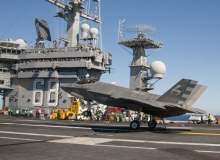
Just after midday on 3 November, Navy test pilot Cmdr. Tony Wilson landed his F-35C test aircraft – designated CF-03 – on the Nimitz’s flight deck. Video shows the Joint Strike Fighter gently cruising in and successfully snagging one of the carrier’s arrestor cables, bringing the aircraft to a rapid stop.
Each aircraft carrier has five arrestor cables dotted along the deck, which ensures pilots can still catch a cable even if they approach too high or too low. Wilson’s landing was inch-perfect with the F-35’s tailhook catching the third cable, considered the ‘sweet spot’ by naval aviators.
"Today is a landmark event in the development of the F-35C," said Wilson, a Navy test pilot with Air Test and Evaluation Squadron (VX) 23.
"It is the culmination of many years of hard work by a talented team of thousands. I’m very excited to see America’s newest aircraft on the flight deck of her oldest aircraft carrier, the USS Nimitz," he added.
The successful landing is the beginning of a two-week testing phase known as Development Testing I (DT-I). During DT-I, the test aircraft will perform a number of operational manoeuvres including various catapult takeoffs and arrested landings. Testing will also encompass general maintenance and fit tests for the aircraft and support equipment.
The two F-35C test aircraft are from Naval Air Station Patuxent River in Maryland.
‘Historic day’ – the beginning of F-35 integration
"What a historic day today is for naval aviation," said Vice Admiral David H. Buss, commander of US naval forces, who was onboard to witness the landings. "With the first traps and catapult launches of the F-35C Lightning II aboard an aircraft carrier, we begin the integration of the next generation of warfighting capability into our carrier-based air wings."
The US Navy awarded a $39.3m contract to Lockheed Martin in April 2012 .
DT-I will be the first of three at-sea test phases for the US Navy’s F-35C variant. The F-35C is specifically designed for aircraft carrier operations and, compared with the Air Force and Marine variants, features larger wings, folding wingtips, upgraded landing gear and greater fuel capacity.
Another unique feature of the ‘Charlie’ variant is the tailhook, which is used to catch the arrestor wires strung across the carrier’s deck and rapidly decelerate the aircraft. Developer Lockheed Martin was forced to redesign the tailhook last year after testing found it couldn’t catch the wires properly.
A new arresting hook system on the F-35C now features better damping and a stronger hook with a redesigned shape.
Critical arrestor tests took place at Naval Air Engineering Station Lakehurst, New Jersey, in January, confirming the new system was ready for carrier landings. Officials were hoping for the first landings to take place in October, but the F-35’s grounding earlier this year due to an engine fire has pushed this further into the year.
The US Navy’s F-35C will take the longest to come into operational service with a projected in-service date of around 2018, compared with 2015 for the F-35B and 2016 for the F-35A. It’s widely known that the US Navy is the least enthusiastic participant in the Joint Strike Fighter programme and so will be using the next two weeks to carefully assess the F-35C’s performance and capabilities.
If the carrier tests reveal yet more problems, expect there to be more calls for buying extra F/A-18s – which are proving their worth in the on-going airstrikes against Islamic State – and a reduction of F-35C orders. Senior naval commanders are already concerned the F-35C lacks sufficient electronic warfare capabilities, a role which is currently being fulfilled by the Navy’s Growler aircraft.
The flawless first landing of the F-35C on the USS Nimitz will silence some of those critics, at least for now.
Follow Grant Turnbull on Google+


.gif)

